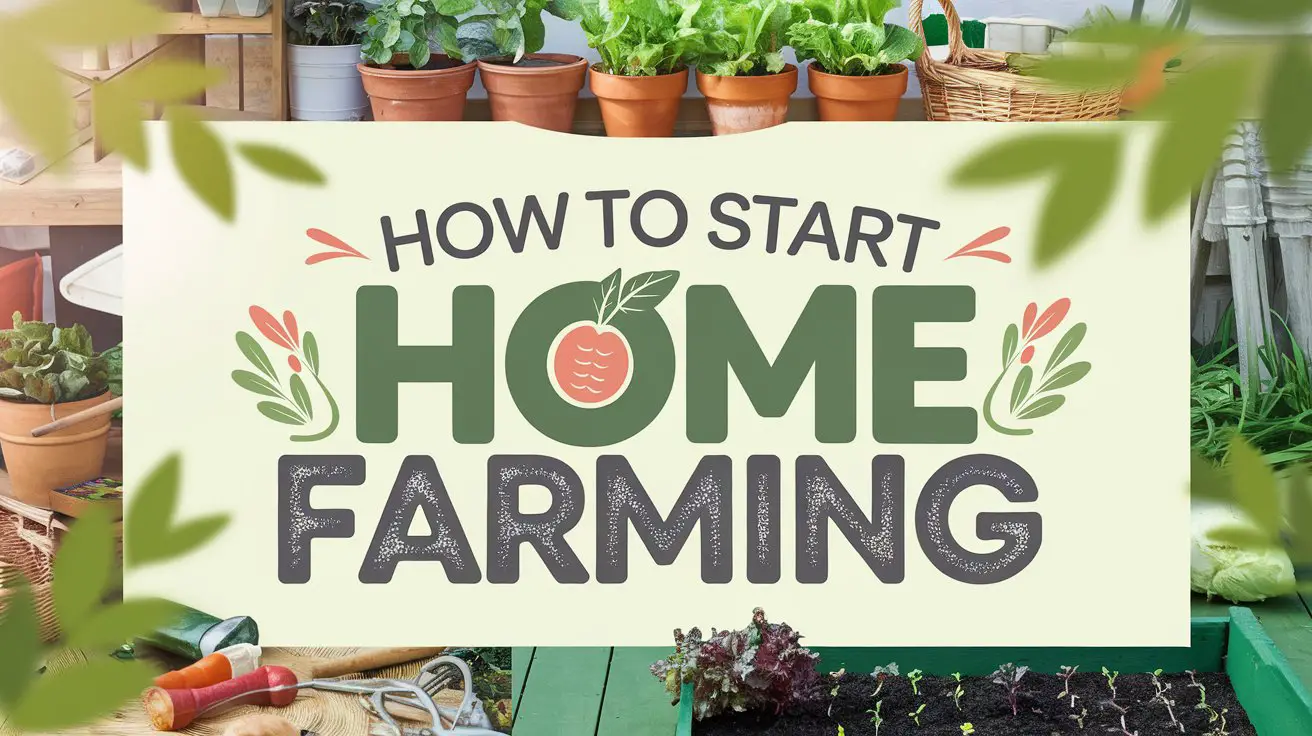Home farming is rapidly gaining popularity as more people seek to embrace sustainable living, enjoy fresh produce, and reconnect with nature. Whether you have a spacious backyard or a small balcony, starting a home farm can be a rewarding and fulfilling endeavor. Growing your own vegetables, herbs, and even raising small livestock not only provides you with fresh, organic food but also helps reduce your carbon footprint. In this guide, we’ll explore how to start home farming, offering tips and advice to help you create a thriving mini-farm right at home.
Understanding Home Farming
Home farming, often referred to as urban farming or backyard farming, involves cultivating plants and, in some cases, raising small livestock for personal consumption or sharing with others. It’s a great way to grow your own food, control what you eat, and enjoy the fruits of your labor. Home farming can range from growing a few potted herbs on your windowsill to managing a full-scale vegetable garden in your backyard.
The beauty of home farming is its scalability. You don’t need acres of land or a lot of experience to get started. With the right knowledge, tools, and a little patience, anyone can cultivate their own food at home. Home farming also allows you to experiment with various gardening techniques, such as organic gardening, vertical gardening, and permaculture, to create a sustainable and productive system.
Planning Your Home Farm
The first step in starting a home farm is planning. Assess your available space, determine what you want to grow, and consider the time and effort you can commit to the farm. If you’re new to farming, it’s wise to start small and gradually expand as you gain experience and confidence.
Consider the climate in your region, as it will significantly impact what you can grow and when you can plant. Research the best crops for your area and choose varieties that are well-suited to your local climate. Make a list of the vegetables, herbs, and fruits you’d like to grow, prioritizing those that you and your family enjoy eating. Additionally, think about the tools and materials you’ll need, such as pots, soil, seeds, and gardening equipment.
If you’re short on space, don’t worry—there are plenty of creative ways to maximize your growing area. Container gardening, vertical gardening, and hydroponics are all excellent options for those with limited space. With careful planning, even a small balcony or patio can be transformed into a productive garden.
Preparing the Soil
Healthy soil is the foundation of a successful home farm. Before planting, it’s important to prepare your soil to ensure it provides the necessary nutrients for your plants to thrive. Start by testing the soil’s pH and nutrient levels, which will help you determine if any amendments are needed. You can purchase a soil testing kit or send a sample to a local agricultural extension office for analysis.
Once you know the condition of your soil, you can amend it with compost, organic matter, or fertilizers to improve its fertility. Compost is an excellent addition to any garden as it enriches the soil with essential nutrients and improves its structure. Regularly adding compost to your garden beds will help maintain soil health and promote robust plant growth.
For container gardens, use high-quality potting soil mixed with compost. Potting soil is specifically formulated to provide the right balance of nutrients, drainage, and aeration for plants grown in containers. Be sure to choose containers with adequate drainage holes to prevent waterlogging, which can lead to root rot.
Selecting and Planting Crops
Choosing the right crops for your home farm is key to a successful harvest. Consider factors such as your local climate, the amount of sunlight your garden receives, and your personal preferences when selecting crops. Some of the easiest vegetables to grow at home include tomatoes, lettuce, carrots, and beans. Herbs like basil, mint, and rosemary are also popular choices for home gardens and can be grown in small spaces.
When planting, follow the recommended spacing and depth guidelines for each type of crop. Overcrowding can lead to poor air circulation, increased risk of disease, and stunted growth. Ensure that your plants have enough room to grow and receive adequate sunlight. Most vegetables require at least six hours of direct sunlight each day, so choose a location that provides sufficient light.
If you’re planting seeds, follow the instructions on the seed packet for proper sowing depth and spacing. For transplants, dig a hole that is slightly larger than the root ball, place the plant in the hole, and fill it with soil. Water the plants thoroughly after planting to help them establish strong roots.
Caring for Your Home Farm
Maintaining a home farm requires regular care and attention. Watering, weeding, and pest control are essential tasks that ensure your plants stay healthy and productive. Consistent watering is crucial, especially during dry spells. Most vegetables need about an inch of water per week, either from rainfall or supplemental irrigation. Water your garden early in the morning or late in the afternoon to minimize evaporation and prevent leaf burn.
Mulching is another important practice that helps retain soil moisture, suppress weeds, and regulate soil temperature. Organic mulches, such as straw, leaves, or wood chips, break down over time and add nutrients to the soil. Apply a layer of mulch around your plants, being careful not to cover the stems or leaves.
Weeding is essential to prevent competition for nutrients and water. Regularly check your garden for weeds and remove them promptly. Mulching can reduce the number of weeds that emerge, but it’s still important to stay vigilant.
Pest control is another aspect of home farming that requires attention. Common garden pests include aphids, caterpillars, and slugs. While it’s natural to encounter some pests, excessive infestations can damage your crops. Practice integrated pest management (IPM) by using a combination of methods such as introducing beneficial insects, applying organic insecticides, and removing pests by hand. Encouraging a diverse ecosystem in your garden can also help keep pest populations in check.
Harvesting and Enjoying Your Produce
One of the most rewarding aspects of home farming is harvesting your own fresh produce. Knowing when to harvest is crucial for getting the best flavor and nutrition from your crops. Each vegetable and fruit has its own ideal harvesting time, which can vary depending on the variety and growing conditions. For example, leafy greens like lettuce and spinach can be harvested as soon as the leaves are large enough to eat, while root crops like carrots and radishes should be harvested when they reach the desired size.
To harvest, use clean, sharp tools to avoid damaging the plants. Cut or pick fruits and vegetables carefully, and handle them gently to prevent bruising. Regular harvesting encourages continued production, so be sure to check your garden frequently and pick ripe produce promptly.
Once harvested, enjoy your homegrown produce in meals, share it with friends and family, or preserve it for later use. Canning, freezing, and drying are popular methods for preserving excess produce, ensuring that you can enjoy the fruits of your labor year-round.
Expanding Your Home Farm
As you gain experience and confidence in home farming, you may want to expand your garden to include more crops or even small livestock. Consider adding fruit trees, berry bushes, or perennial herbs to your garden for a more diverse and sustainable system. If you have the space and interest, raising chickens, rabbits, or bees can be a rewarding addition to your home farm, providing fresh eggs, meat, or honey.
Additionally, exploring advanced gardening techniques like crop rotation, companion planting, and permaculture can help you maximize your garden’s productivity while maintaining soil health. These practices promote biodiversity, reduce the risk of pests and diseases, and create a more resilient ecosystem.
Benefits of Home Farming
Home farming offers numerous benefits beyond just providing fresh food. It promotes a healthier lifestyle by encouraging you to eat more fruits and vegetables and engage in physical activity. Gardening has been shown to reduce stress, improve mental health, and provide a sense of accomplishment. Home farming also contributes to sustainability by reducing your reliance on store-bought produce, cutting down on food miles, and minimizing your environmental impact.
Furthermore, home farming fosters a connection to nature and a deeper appreciation for where your food comes from. It’s a valuable educational experience for children and adults alike, teaching essential skills such as patience, responsibility, and problem-solving.
Conclusion
Starting a home farm is a fulfilling journey that brings you closer to nature, promotes sustainable living, and provides a steady supply of fresh, healthy produce. Whether you have a large backyard or a small balcony, with careful planning, preparation, and dedication, you can create a thriving home farm that meets your needs. From selecting the right crops to maintaining healthy soil and practicing effective pest control, every step you take brings you closer to enjoying the fruits of your labor.
Embrace the process, learn from your experiences, and gradually expand your farm as your skills and confidence grow. Home farming is more than just growing food; it’s about cultivating a lifestyle that values self-sufficiency, sustainability, and the simple pleasures of working with the earth.





